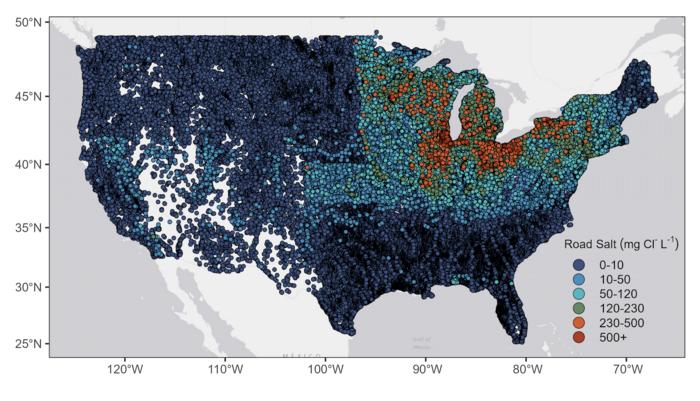Since de-icing with road salt began in the 1930s, the salinity of lakes across much of the US has been steadily increasing, posing a potential threat to aquatic life and drinking water supplies. However, a cautiously optimistic new study in Limnology and Oceanography Letters concludes that if we can hold steady or decrease road salt use, levels in many lakes could stabilize below thresholds set by the US Environmental Protection Agency (EPA).

Credit: Solomon, C.T., Dugan, H.A., Hintz, W.D., Jones, S.E. (2023). Upper limits for road salt pollution in lakes. Limnology and Oceanography Letters.
Since de-icing with road salt began in the 1930s, the salinity of lakes across much of the US has been steadily increasing, posing a potential threat to aquatic life and drinking water supplies. However, a cautiously optimistic new study in Limnology and Oceanography Letters concludes that if we can hold steady or decrease road salt use, levels in many lakes could stabilize below thresholds set by the US Environmental Protection Agency (EPA).
“For the majority of US lakes, road salt pollution could be a solvable problem, if we put our minds to it,” said lead author Chris Solomon, who studies lake ecology at Cary Institute of Ecosystem Studies. However, he cautions that more research is needed to better understand what actually is a safe level of salt in a freshwater ecosystem.
The US applies an estimated 24.5 million tons of road salt on its roads every winter — mostly in the form of sodium chloride. Rain and melting snow carry this salt into local waterways and aquifers, where it can cause freshwater salinization syndrome. Not only is this salt harmful to many organisms, but it can leach toxic metals and radioactive materials from soil and water pipes.
Solomon saw the upward-trending lines of salt concentrations in US lakes and wanted to find out where they were headed. Would road salt levels continue to rise, or would they stabilize? With colleagues, he developed a model to explore controls on road salt concentration in lakes to reveal the concentration at which they might level off.
The model looked at road density in lake watersheds, the amount of road salt applied per road mile, and precipitation. Hydrologic fluxes were taken into account to predict how salt pollution flows into and out of lakes. The model calculated the levels at which road salt would be expected to stabilize if salt application was held at amounts reported in 2010-2015, for all of the 461,000 lakes and reservoirs larger than 2.5 acres in the contiguous US.
For lakes in areas with light to moderate road density, the authors found that holding road salt application rates steady could help lakes stabilize below 230 mg/l of chloride per liter of water, the threshold designated by the EPA to protect aquatic life. Reducing application could yield additional environmental and economic benefits without threatening road safety.
The authors note that more research is needed to determine if the EPA’s 230 mg/l chloride threshold is too high. Solomon explains, “The EPA’s chronic toxicity thresholds for chloride were developed with limited data, and there is growing evidence that negative impacts can occur at concentrations well below 230 mg/l.” Even less is known about how salt mixtures from multiple sources affect aquatic life.
Some places have set much lower chloride guidelines, including 150 mg/L in Michigan and 120 mg/L in Canada. The model predicts that chloride concentrations will eventually exceed the 120 mg/L threshold in more than 9,000 US lakes, even if road density and salt application rates stay at current levels.
Unsurprisingly, lakes with predicted salt concentrations in excess of EPA’s 230 mg/l thresholds were most common in the Northeast and Midwest. Most vulnerable were lakes with high road density and high road salt application in their watersheds. They included some 9-10% of lakes in Illinois and Ohio, as well as a smaller percentage of lakes (<0.1 to 1%) in Indiana, Iowa, Kansas, Michigan, Minnesota, New York, Pennsylvania, and Wisconsin.
Achieving safe salt levels in these lakes will require reductions in salt use. This can be done safely by adopting best management practices and new technologies.
As a test of the model’s accuracy, predictions were compared to measurements taken at Mirror Lake in New Hampshire, a site that has been monitored since 1967 by Cary Institute founder Gene E. Likens. After plugging in the local data, the model predicted maximum and minimum salt levels, and the real-world measurements fell within the predicted range. “This gives us confidence that we’re in the right ballpark,” said Solomon.
“We don’t think the model is perfect. It’s a simple model that’s meant as a tool for thinking through the problem,” Solomon says. Among other things, the model ignores salt inputs from natural rock weathering and from human activities like agriculture and industry, and does not consider temporary seasonal spikes in chloride. “We hope others will elaborate on the approach and make better predictions. But in the meantime our results suggest that efforts to control salt application can make a big difference, and may help to prioritize those efforts,” Solomon concludes.
Next steps include comparing the model’s predictions to observed data in other places where salt application and lake chloride levels have been documented for many years, and using the model to explore how other forms of global change — such as land use or climate change — alter both precipitation and the need for road salt application.
Citation
Solomon, C.T., Dugan, H.A., Hintz, W.D., Jones, S.E. (2023). Upper limits for road salt pollution in lakes. Limnology and Oceanography Letters.
Investigators
Christopher T. Solomon – Cary Institute of Ecosystem Studies
Hilary A. Dugan – University of Wisconsin–Madison
William D. Hintz – The University of Toledo
Stuart E. Jones – University of Notre Dame
This research is based on work supported in part by the National Science Foundation.
Cary Institute of Ecosystem Studies is an independent nonprofit center for environmental research. Since 1983, our scientists have been investigating the complex interactions that govern the natural world and the impacts of climate change on these systems. Our findings lead to more effective resource management, policy actions, and environmental literacy. Staff are global experts in the ecology of: cities, disease, forests, and freshwater.
Journal
Limnology and Oceanography Letters
DOI
10.1002/lol2.10339
Method of Research
Computational simulation/modeling
Subject of Research
Not applicable
Article Title
Upper limits for road salt pollution in lakes
Article Publication Date
25-Jul-2023




